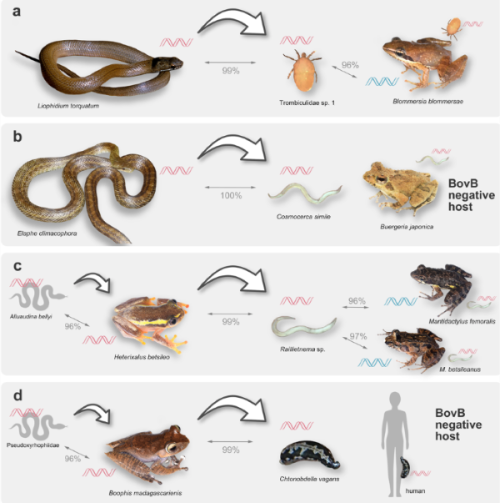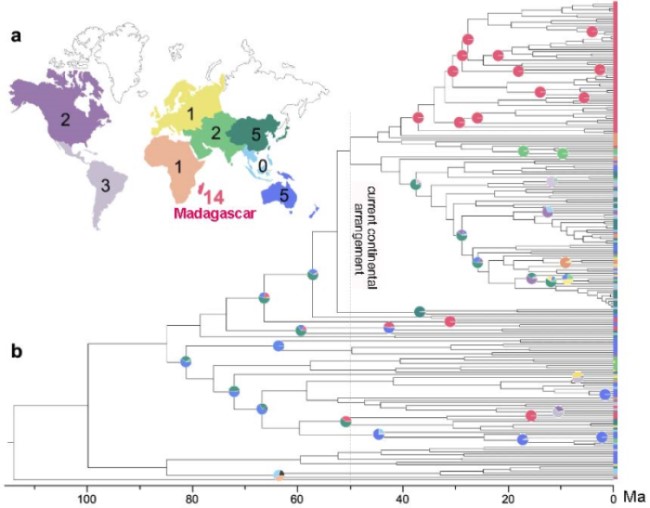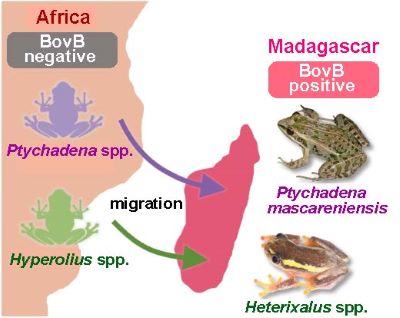Do the Genes Jump from Snakes to Frogs?
-Pandemic of Horizontal Gene Transfer Mediated by Parasites-
A group of 15 research institutes in Japan and overseas, including Professor SATO Hiroshi and Associate Professor YANAGIDA Tetsuya of Yamaguchi University, Joint Faculty of Veterinary Medicine, Associate Professor KURABAYASHI Atsushi of Nagahama Institute of Bio-Science and Technology, KAMBAYASHI Chiaki (post-doctoral student), KAKEHASHI Ryosuke, Specially Appointed Assistant Professor, OHSHIMA Kazuhiko, Associate Professor FURUNO Nobuaki of Hiroshima University, Associate Professor TANABE Hideyuki of the Graduate University for Advanced Studies, Professor OTA Hidetoshi of University of Hyogo, and Associate Professor HOSO Masaki of Waseda University, discovered that genes (retrotransposons called BovB) were horizontally transmitted from snakes to frogs (Figure 1). Studies using large numbers of snake and frog samples collected from all continents of the world revealed that the frequency of horizontal transmission varied from region to region, and it became clear, especially in Madagascar that the frequency was high enough to be called a pandemic (Figure 2).
Additionally, we discovered possible parasite vectors that may mediate this horizontal gene transfer (Fig. 1). The frequency of the potential parasite vectors was also high in Madagascar, suggesting that horizontal transmission among vertebrates depends on the frequency of the parasite vectors in each region. Furthermore, we discovered that the horizontal transmission to frogs occurred in Madagascar after migration from African continent where horizontal transmission was not confirmed (Figure 3). Based on these results, we present a novel concept that horizontal transmission occurs by a mechanism similar to that of the transmission of endemic diseases, such as malaria.
The results of this research were published in the electronic edition of the British academic journal, “Molecular Biology and Evolution” on April 12, 2022 (noon).
 Figure 1.
Figure 1.
Typical examples of horizontal transmission pathway via parasites. Thick arrows indicate the direction of transmission, and thin arrows indicate the nucleotide sequence homology of BovB between animals. Red DNA symbols show BovB horizontally transmitted from snakes to frogs or from snakes to parasites, and blue symbols indicate BovB originally carried by the frog.

Figure 2.
- Numbers at each region indicate the number of horizontal gene transfer occurring within the past 50 million years, the time after the current continental arrangement was established.
- Phylogenetic tree constructed from the nucleotide sequences of BovB. The position of pie charts indicates the estimated time when horizontal transmission occurred. The color and area of each pie chart represent the region (corresponding to Fig. 2a) and probabilities of the occurrence of horizontal transmission.

Figure 3.
Horizontal transmission occurred in these two frog lineages after migration from Africa to Madagascar.
Research Points
- It was discovered that a gene (BovB) jumped from snakes to frogs (horizontal gene transfer).
- Although horizontal gene transfer between vertebrates is considered to be very rare, our study demonstrated that the horizontal transmission from snakes to frogs has occurred many times around the world, especially in Madagascar, where a pandemic of horizontal gene transfer was observed.
- Human blood-sucking leeches carried the frog BovB, indicating that gene transfer may be occurring not only from snakes to frogs, but also among many other animals.
- It is highly possible that horizontal transmission from snakes to frogs was mediated by parasites, and the proportion of parasites possessing BovB was high especially in Madagascar. In addition, it was found that the horizontal transmission in two frog lineages occurred after migration from Africa to Madagascar.
- Although the mode of horizontal gene transfer among multicellular animals is poorly understood, this study provides a completely new perspective; horizontal transmission between vertebrates occurs by a mechanism similar to that of endemic diseases, such as malaria.
Reference Information
- Journal: Molecular Biology and Evolution
- Research Title: Geography-dependent horizontal gene transfer from vertebrate predators to their prey
- Joint Researchers: Chiaki Kambayashi, Ryosuke Kakehashi, Yusuke Sato, Hideaki Mizuno, Hideyuki Tanabe,Andolalao Rakotoarison, Sven Künzel, Nobuaki Furuno, Kazuhiko Ohshima, Yoshinori Kumazawa, Zoltán T. Nagy, Akira Mori, Allen Allison, Stephen C. Donnellan, Hidetoshi Ota, Masaki Hoso, Tetsuya Yanagida, Hiroshi Sato, Miguel Vences
- D O I: 10.1093/molbev/msac052
- URL: https://academic.oup.com/mbe/advance-articles
- Release Date: April 12, 2022 (noon) Japan time